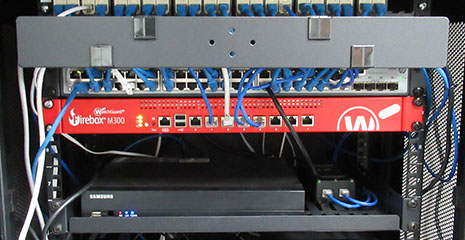If You Connect It, Protect It
Did You Know?
As companies moved employees to work from home, cybercriminals took advantage of the pandemic-driven vulnerabilities, increasing DDoS (distributed denial of service) attacks by 25% during the pandemic lockdown, with more than 929,000 attacks in May alone.1
Cyber attacks are constantly evolving and never take time off. For this reason, it is critical that your network security also evolves and works 24/7. Although network security can get complicated and time-consuming, it doesn't have to be. Offload your network security to the experts at Thinix. Our team can help you secure your endpoints, manage your firewalls, and more. Check out our top cybersecurity services below.
Top Cybersecurity Solutions
10 Cybersecurity Best Practices
A hacker attack occurs every 39 seconds. Better protect your business and network by adopting these ten best practices.

1. Have a properly configured firewall & security protocols in place
Firewalls are powerful devices that help keep your network safe. Your firewall should provide intrusion prevention service, APT blocker, offsite logging, user-application controls, packet filtering, and security audits.

2. Regularly push updates & patches
Whether it’s software, applications, or devices it’s important to keep them updated. Updates and patches eliminate vulnerabilities that hackers use to access your network and exploit your data.

3. Replace or upgrade your outdated & obsolete/end-of-life devices & software
Devices and software that are considered end-of-life or obsolete no longer receive updates, patches, and support. Without continued updates and patches, the devices and software are forever left vulnerable to cyber attacks.

4. Manage permissions for users, devices, & applications
Reduce the risk of cyber attacks by limiting what users, devices, and applications have access to. This often includes blocking websites that may be or are known to be harmful. If users can’t access it, they can’t accidentally introduce a cyber attack to your network.

5. Routinely monitor the network for malicious activity & rogue devices
Keep track of the activity on your network. By routinely monitoring your network, you can easily spot unusual and malicious activity. With regular surveillance, you can also better detect rogue devices that may pose a threat to your network.

6. Backup your data to secure location(s)
It’s no longer good enough to simply have a copy of your data in a single location. Cyber attacks have become more sophisticated and can access simple backups. It is best to have multiple backups saved across multiple locations, so even if one is compromised, you are still able to easily recover.

7. Have email security in place
Many cyber attacks enter networks through emails by unsuspecting users clicking harmful links or opening corrupted attachments. Protect your users and network by deploying email security protocols that help block spam and malicious emails from reaching user inboxes.

8. Provide ongoing cybersecurity education to employees
One simple and inexpensive way to keep your network secure is to provide ongoing cybersecurity education to your employees. When you keep your employees informed on how to spot malicious activity/emails, along with what to do should they come across something they’re unsure of, you reduce the chances of experiencing a cyber attack.

9. Perform network assessments on a regular basis
The best way to know what your network’s strengths and weaknesses are is to perform regular network assessments. Assessments help you prevent issues and eliminate potential vulnerabilities that could be exploited.

10. Have response plans and procedures in place
Instead of being caught off-guard and left to pick up the pieces, create response plans and procedures so your team can proactively halt cyber attacks and reduce any potential damage.



